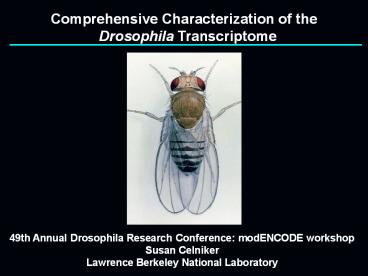Comprehensive Characterization of the - PowerPoint PPT Presentation
1 / 22
Title:
Comprehensive Characterization of the
Description:
IU: Peter Cherbas, Justen Andrews, Lucy Cherbas, Dayu Zhang, David Miller, ... Laura Langton, Marijke J. van Baren, Aaron E. Tenney, Charles L. G. Comstock and ... – PowerPoint PPT presentation
Number of Views:98
Avg rating:3.0/5.0
Title: Comprehensive Characterization of the
1
Comprehensive Characterization of the
Drosophila Transcriptome
49th Annual Drosophila Research Conference
modENCODE workshop Susan Celniker Lawrence
Berkeley National Laboratory
2
ModENCODE Project Goals
SPECIFIC AIM 1 Identify protein coding and
non-protein coding transcribed sequences 1.1
Prepare RNA samples from representative
developmental, tissue and cell types 1.2
Produce 38 bp resolution expression profiles of
the transcriptome for all RNA samples 1.3
Produce 7 bp expression profiles for a carefully
selected subset of samples 1.4 Identify
composite exon sets with pooled gene specific
targets Co-PIs - Peter Cherbas (IU) and Tom
Gingeras (Affymetrix) SPECIFIC AIM 2 Map
transcript structures 2.1 Synthesize data
to produce and refine transcript models 2.2
Map TSS, exon/intron junctions and polyA sites by
RLM-RACE, RT-PCR and cDNA sequencing
2.3 Characterize and validate ncRNAs by 454
Life Science pyrosequencing 2.4 Map
cis-elements required for RNA splicing by RNAi of
RNA-binding proteins Co-PIs - Michael Brent
(WU),Roger Hoskins (LBNL) and Brenton Graveley
(UCHC) SPECIFIC AIM 3 Functionally validate
ncRNAs 3.1 RNAi using cell-based assays
3.2 Overexpression using cell-based
assays Co-PI - Norbert Perrimon (Harvard)
3
How many genes in Drosophila?Current estimates
FlyBase
4
Aim 1Expression
- 300 RNA samples in biological triplicate
- 300 samples on 38-bp genome tiling arrays
- 24 samples on 7-bp genome tiling array sets
- 160 RACE-fragment pools (16,000 prods)
- Comprehensive identification of transcribed
sequences by microarray hybridization and next
generation sequencing.
5
RNA Samples
6
Cell Lines represent specific lineages
expressed at high level
not detectable
D16-c3
fng
Antp
tsh
elB
ci
pnr
fz3
CI.8
Antp
tsh
ci
fng
fz3
pnr
Lucy Cherbas
7
Expression Analysis of 15 Drosophila cell lines
Base-pair coverage for individual cell lines
Base-pair coverage for the union of expression
Unique transcription per cell line
- all transfrags created with bandwidth 50, min-run
90, max-gap 90 - interrogated genomic space is calculated using
blanket transfrags which are created assuming
all probes are above threshold - https//dgrc.cgb.indiana.edu/cells/store/catalog.h
tml
8
Improved exon discrimination using 7bp arrays
9
Comparison of ML-DmD20 cell lines clone2 versus
clone5
clone2 RNA
clone5 RNA
2 and 5
5 not 2
2 not 5
- Intergenic transcription downstream of hairy (h)
10
Specific Aim 2 Synthesis and Validation
- Synthesis of RNA expression data, comparative
data and gene predictions. - 20,000 short RT-PCRs
- 20,000 RACE experiments
- Small RNA sequencing on 454 16 runs
- 6,000 cDNA screens 3,000 long RT-PCRs
- RNAi of 120 RNA binding proteins on arrays
- Identify cis-reg. elements in control of splicing
11
Modeling and Validation
Conserved exons MIT
GenBank Accession s 49077286 - 49077870
Michael Brent, Charlie Comstock, Laura Langton
and Jeltje van Baren
12
Solexa sequencing to verify splice sites
Intron Statistics
DMG2
DMG3
13
Analysis of transcription start sites
RE, RH
Single dominant Peak 1,002/2,738
Broad 63/2,738
Broad with dominant Peak 981/2,738
Multimodal Peak 692/2,738
Ben Booth and Joseph Carlson, LBNL
Classification Carninci et al., 06
14
Motif Abundance
15
RLM cDNA Library
Charles Yu, Roger Hoskins and Joseph Carlson, LBNL
16
cDNA Library Screening Using iPCR
- Summary
- Attempts 3,829
- Recovered 2,047
- Success rate 53
- Advantages over RT PCR
- Captures 5 and 3 UTRs
- Captures splice variants
- Extends predictions
Hoskins et al., (2005) NAR 33(21)e185 Wan et
al., (2006) Nat Proto 1624
17
cDNA Sequencing Corrects Gene Models
18
Power of Evolutionary Signatures for Exon
Identification
High protein-coding signal, low
conservation Ability to recognize fast-evolving
exons
High conservation, but not protein-coding
Evolutionary signatures specific to function
Collaboration with Manolis Kellis Stark et al,
Nature 2007 450219 Lin et al., Genome Res. 2007
171823
19
Validation of the Transcriptome
Comparison of FlyBase Release 5.2, 5.5
Annotations and BDGP and Exelixis ESTs, BDGP
cDNA and modENCODE RT-PCR data
20
(No Transcript)
21
Plans for demonstrating biological relevance of
ncRNAsRNAi screens
DRSC dsRNAs arrayed in 384-well plates
Microscopy-base assays
Plate reader-based assays
Transcriptional-Luciferase Reporter Assays
Protein modification (phospho-specific antibodies)
GFP or antibodies
(Aerius)
P-Akt level
Cell number
Z-scores
700 nm
800 nm
DRSC Drosophila RNAi Screening Center, Harvard
Medical School http//flyrnai.org/ -
Mathey-Prevot and Perrimon
22
Acknowledgements
modENCODE Drosophila Transcriptome Project
- UCB Angela N. Brooks, Kasper D. Hansen, Sandrine
Dudoit and Steven E. Brenner - LBNL Roger Hoskins, Ann S. Hammonds, Joseph W.
Carlson, Kenneth H. Wan, Charles Yu and Benjamin
Booth - IU Peter Cherbas, Justen Andrews, Lucy Cherbas,
Dayu Zhang, David Miller, Andreas Rechsteiner,
Thomas C. Kaufman and Justin P. Kumar - WashU Laura Langton, Marijke J. van Baren, Aaron
E. Tenney, Charles L. G. Comstock and Michael
Brent - Affymetrix and CSH Aarron T. Willingham, Philipp
Kapranov, Srinka Ghosh and Thomas R.Gingeras - UCHC Michael O. Duff, Li Yang, and Brenton R.
Graveley - Harvard Norbert Perrimon, Stephanie Mohr and
Bernard Mathey-Prevot - Funding modENCODE NHGRI, expression NHGMS

